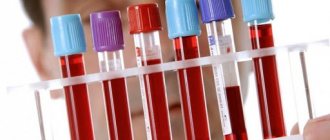What do elevated triglycerides mean?
According to most domestic and foreign experts (in particular, from the AHA - American Heart Association), very high levels of triglycerides, to a greater extent, indicate problems in the LIVER or PANCREAS.
And also at increased risks of developing pre/diabetes and type II DIABETES (due to insulin/resistance, which we will discuss later in this article). IT WOULD BE NICE TO KNOW:
What are (TG) triglycerides and what is their norm for women and men (by age)?
With regards to the direct effect of high levels of TG in the blood plasma in women and men on the risks of developing cardiovascular diseases, the results of modern studies have shown rather contradictory results. Therefore, NOT (!) all experts agree that specifically - an increased level of triglycerides - is one of the main “culprits” of diseases of the heart, brain and blood vessels ( atherosclerosis
).
And there are 2 main reasons for this:
- Firstly
, high levels of TAG (triacylglycerides) in the blood most often appear along with problems such as obesity, hypertension, and diabetes.
And also decreased levels of “good” HDL cholesterol and, conversely, increased levels of conditionally “bad” LDL cholesterol . In this regard, it is quite difficult to determine which problems are caused SPECIFICALLY by the level of triglycerides - ABOVE NORMAL. - Secondly
, recent research results involving patients with a genetic predisposition to high triglyceride levels (familial / hereditary hypertriglyceridemia) have shown that they are NOT (!) at high risk of developing cardiovascular diseases. Although, there is some official evidence that high triglycerides can still play some kind of negative role, BUT (!) Insignificant.
YOU MAY BE INTERESTED IN:
Triglycerides in the blood are low, what does this mean and how to increase them?
Reduce your sugar intake
Sugar is a form of carbohydrate and is high in calories. Foods high in simple sugars, especially refined fructose, can raise triglyceride levels. Added sugar comes in many forms, including:
- white sugar
- Brown sugar
- honey
- cane juice or cane syrup
- corn sweetener or corn syrup
- fruit juice concentrate
- glucose
- fructose
- dextrose
- maltose
- lactose
- sucrose
- syrups such as maple, agave and molasses
Added sugar should be avoided to reduce triglyceride levels.
Instead of sugar, sprinkle spices such as cinnamon or ginger onto your cereal or oatmeal to add flavor. Choose fruit desserts instead of ice cream or sticky puddings. When purchasing ready-to-eat foods, remember that many of them, including some savory foods such as tomato ketchup, contain added sugar.
Every 4 grams of sugar is equivalent to 1 teaspoon. Cardiologists recommend a daily maximum sugar intake of 25 g (about 6 teaspoons) for women and 36 g (9 teaspoons) for men.
Are there tangible signs of impairment?
An increase in the level of triglycerides in the blood is not accompanied by visible manifestations, therefore, before a medical examination, hypertriglyceridemia can only be recognized through the symptoms of existing complications:
- compression and pain in the heart (angina), attacks of shortness of breath (dyspnea);
- heaviness in the right side, palpable enlargement of the liver (hepatomegaly);
Xanthomas around the eyes.
- blurred vision, headache, dizziness;
- excessive psycho-emotional excitability, frequent mood swings;
- persistent increase in blood pressure (hypertension);
- insomnia or, conversely, drowsiness, chronic fatigue syndrome;
- the appearance of yellowish lumps (xanthoma, xanthelasma) on the face or body.
Important! The common belief that with high triglyceride levels, a person will necessarily be overweight is wrong: moreover, hypertriglyceridemia occurs even in people who are underweight. It all depends on the cause of the increase, as well as the individual characteristics of the body.
Sample meal plan
Below is a sample meal plan that may help lower your triglyceride levels.
| Option 1 | Option 2 | Option 3 | |
| Breakfast | salmon, poached egg and watercress, whole grain rye bread | buckwheat pancake with blueberries and low-fat yogurt | porridge with low-fat or vegetable milk, sprinkled with pumpkin seeds and berries |
| Dinner | Avocado, spinach, tomato and hummus salad | lentil and vegetable soup with oatcakes | sardines on whole grain toast with a side of salad greens |
| Dinner | stir-fry chicken and vegetables with brown rice | butternut squash and tofu curry, served with cauliflower rice | vegetable and bean chili, served with stewed cabbage |
| Snack | banana, almonds | boiled egg and whole grain pita slices | celery sticks and nut butter |
What does elevated triglycerides mean?
An increase in lipids may be a sign of the diseases described above. Often, a person may not realize they are at risk until they are tested. Elevated triglycerides mean that the patient must follow a diet that will help normalize his blood and lower cholesterol. This also indicates that there is a risk of cardiovascular diseases, liver cirrhosis and hepatitis.
- What are triglycerides in a biochemical blood test?
Elevated blood triglycerides in men
In the stronger sex, the TG level is always slightly higher than in the weaker sex. Elevated triglycerides in the blood in men can occur due to smoking, constant consumption of alcoholic beverages, overeating, and frequent stress. After receiving the test results, you should definitely consult a doctor and undergo a course of treatment.
Elevated triglycerides in women
When it comes to high lipid levels, women are at greater risk than men. Elevated triglycerides in women can occur:
- while taking birth control pills that include the hormone estrogen;
- during pregnancy;
- with polycystic ovary syndrome;
- during menopause;
- for hormonal disorders;
- infertility.
Triglycerides are elevated during pregnancy
An increase in the number of lipids in the mother's blood during fetal development is not uncommon. Many pregnant women have increased cholesterol levels during this period, and this is normal, which cannot be said about triglycerides. The expectant mother will have to reduce the consumption of foods rich in TG in order for the indicators to be normal. If triglycerides are elevated during pregnancy, this does not mean that the development of the fetus is abnormal. Often the reason for this test result is simple overeating or changes in hormonal levels.
Triglycerides are elevated in a child
What does an increase in triglycerides mean? The most common reasons are presented below:
- obesity and excess weight;
- poor nutrition;
- consumption of unhealthy foods (chips, fast food, sweets);
- hereditary genetic abnormalities.
When triglycerides are elevated in a child, the problem becomes more difficult to solve. It can be difficult for children to explain why their parents deny them the usual things. You should force your child or teenager to eat healthy foods and take fish oil. Parents will have to closely monitor the child’s diet and physical activity. In addition, you should consult a doctor and conduct a comprehensive examination of the body.
Limit carbohydrates
You should limit your total carbohydrate intake to less than 60% of your recommended daily calorie intake. If you consume more carbohydrates than you need, your body will store them as fat. There are many ways to avoid carbs, such as eating lean burgers with lettuce instead of a sweet cream bun. Some carbohydrate foods, including some grains, may be beneficial in the diet. However, refined carbohydrates such as white bread provide few nutrients and add calories to the diet.
To get more healthy carbohydrates, choose whole grains, oatmeal and vegetables such as carrots. For dessert, choose fresh or frozen blueberries, blackberries or raspberries instead of sweet baked goods. These fruits can reduce sugar cravings and also provide healthy carbohydrates. Not only are unrefined carbohydrates a source of dietary fiber, but they also provide faster and longer-lasting satiety than refined carbohydrates because they release their energy more slowly.
Features of hypertriglyceridemia in men
The level of triglycerides in men increases with age. Due to the higher content of cholesterol and TG, men more often than women suffer from early coronary heart disease, brain disease, strokes, and myocardial infarction.
Elevated triglycerides in men of all ages are most often a consequence of poor nutrition and bad habits. Other common causes are diabetes, previous myocardial infarction, and kidney disease. Older men with gout have high TG levels.
Choose the right fats
The body needs fats to function properly, but some fats are healthier than others. Choosing healthy fats can lower triglyceride levels. Solid fats come from meats, full-fat dairy products, and some tropical oils such as coconut and palm. These foods contain trans fats and saturated fats. Trans fats and saturated fats increase triglyceride levels and should be replaced wherever possible.
Unsaturated fats, especially polyunsaturated fats (PUFAs), lower triglyceride levels. Avocados and olive oil contain monounsaturated fats. Omega-3 fats are found in fish oil, flaxseed and cold-water fish such as salmon and sardines. You can add PUFAs to your diet by consuming these foods. Instead of a steak or hamburger, which is high in saturated fat, you can opt for a salmon fillet or a tuna sandwich. Animal products such as lean meats, fresh poultry, low-fat or low-fat dairy products and seafood are also good options. Fats should make up 25 to 35 percent of the diet.
Normal levels of triglycerides in the blood of women and men
| Patient age | |
| Under ten years old | M 0.340 - 1.130 |
| F 0.40 - 1.240 | |
| From ten to fifteen years | M 0.360 - 1.410 |
| F 0.420-1.480 | |
| About fifteen to twenty years old | M 0.420 - 1.670 |
| F 0.440 - 1.40 | |
| Twenty to twenty-five years old | M 0.50 - 2.270 |
| F 0.410 - 1.480 | |
| Twenty-five to thirty years old | M 0.520 - 2.810 |
| F 0.420 - 1.630 | |
| Thirty to thirty-five years old | M 0.560 - 3.010 |
| F 0.440 - 1.70 | |
| From thirty-five to forty years old | M 0.610 - 3.620 |
| F 0.450 - 1.990 | |
| Forty to forty-five years old | M 0.620 - 3.610 |
| F 0.510 - 2.160 | |
| Forty-five to fifty years old | M 0.650 - 3.70 |
| F 0.520 - 2.420 | |
| Fifty to fifty-five years old | M 0.650 - 3.610 |
| F 0.590 - 2.630 | |
| Fifty-five to sixty years old | M 0.650 - 3.230 |
| F 0.620 -2.960 | |
| From sixty to sixty-five years old | M 0.650 - 3.290 |
| F 0.630 - 2.70 | |
| From sixty-five years old | M 0.620-2.940 |
| F 0.680 - 2.710 |
It should be noted that the norm of triglycerides in the blood of women after 50 years increases and approaches the “male norm” due to the onset of menopause and changes in hormonal levels.
- Reactive arthritis in a child, have you ever encountered this?
Prevention
Prevention when the TG index in women deviates from the norm, both upward and downward, is the same:
- Proper nutrition depending on the deviation from the norm of TG concentration in the blood;
- Quitting bad habits - chronic alcohol and nicotine addiction;
- Lead an active lifestyle and adequately load the body daily;
- Women undergo lipid biochemistry every 6 months after menopause.
Exercises
Physical activity also plays a vital role in reducing triglyceride levels. Burning calories ensures that the body uses more of its triglycerides. Any exercise is beneficial, but the extent of its impact will depend on:
- initial triglyceride levels
- exercise intensity level
Walking for 30 minutes every day is a great way to get started. It is recommended that adults do 150 minutes of moderate aerobic activity, 75 minutes of vigorous aerobic activity, or a combination of both each week.
Preparing for the test
Blood is donated for lipid profile in the morning. To determine the level of each lipid fraction, there are its own preparatory rules:
- Total cholesterol - given at any time of the day without the need for a twelve-hour fast. For the objectivity of the result, it is recommended to perform the analysis two months after surgery, delivery, injury, infection or heart attack;
- PAP – requirements are similar to the previous paragraph;
- LDL - taken only in the morning, on an empty stomach, after a twelve-hour fast (excluding any food and drinks except water). The day before blood sampling, it is important to exclude any alcohol;
- Triglycerides - requirements are similar to the previous paragraph.
When taking a general lipid profile (with the study of all markers), you must adhere to the rules of a twelve-hour fast and donate blood in the morning. During the day before the procedure, it is necessary to avoid any alcoholic drinks and alcohol-containing medications (syrups and drops for oral administration). It is not advisable to smoke an hour before the test. Psycho-emotional and physical stress of increased intensity should be excluded immediately before taking biological material.
Analysis results in our laboratory and research base are prepared within 24 hours. After this, they are assessed by a supervising specialist. A detailed study may include additional indicators - the levels of apolipoprotein A1 and apolipoprotein B. If necessary, the concentration of very low density cholesterol (VLDL) is studied.











